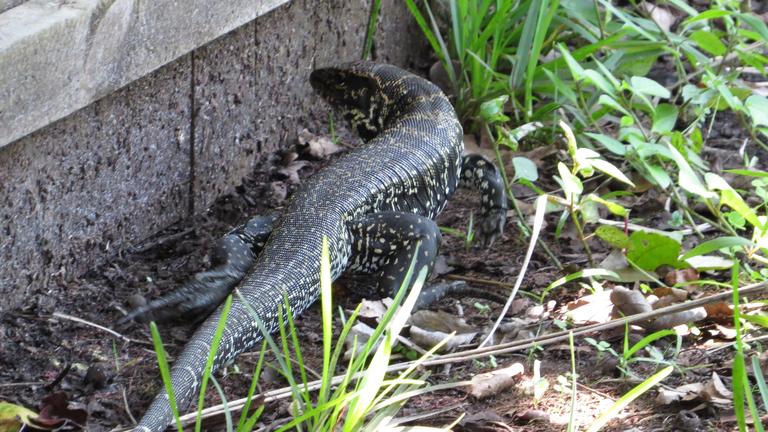EDRR Invasive Species
Black and White Argentine Tegu
(Salvator merianae)
Define Invasive Species: must have all of the following –
- Is non-native to the area, in our case northwest Florida
- Introduced by humans, whether intentional or accidental
- Causing either an environmental or economic problem, possibly both
Define EDRR Species: Early Detection Rapid Response. These are species that are either –
- Not currently in the area, in our case the Six Rivers CISMA, but a potential threat
- In the area but in small numbers and could be eradicated
Native Range:
The Argentine Black and White Tegu is native to South America.
Introduction:
The tegu was introduced to Florida through the pet trade. Some animals either escaped or were released.
EDDMapS currently list 7,014 records of the Argentine Black and White Tegu in the U.S. 5,908 (84%) are from Miami-Dade County. There are 12 records from Georgia and one from Memphis Tennessee. The majority of records are from south Florida.
There are 12 records from the Florida panhandle and five within the Six Rivers CISMA. The only confirmed breeding pairs are in Miami-Dade, Hillsborough, and Charlotte counties in Florida.
Description:
Tegus are long black and white banded lizards that can reach four feet in length. They prefer high dry sandy habitats but can be found in a variety of habitats including agricultural fields.
Issues and Impacts:
Basically… they eat everything. Being omnivores, stomach analysis indicates they will feed on fruits, vegetables, eggs, insects, and small animals. These animals include lizards, turtles, snakes, lizards, and small mammals. They feed primarily on ground dwelling creatures. A typical tegu clutch will have 35 eggs.
The consumption of fruits and vegetables can have a major impact on agricultural row crops throughout Florida. Their habit of consuming eggs would include the American alligator, the American crocodile, and the gopher tortoise – all protected species.
Records show the number of tegus trapped each year is growing, with over 1400 captured in 2019. This suggests the populations are increasing and new breeding colonies are probable. There are also records of the animal in north Florida and Georgia, suggesting they can tolerate the colder winters of those regions.
Management:
Management is currently with trapping. Both the Florida Fish and Wildlife Conservation Commission and their subcontracted trappers are currently the primary method of removing the animals. Researchers from the University of Florida as well as those mentioned above frequently conduct roadside surveys searching for these animals. We ask anyone who has seen a tegu to report it on the IveGotOne App found on the EDDMapS website – www.eddmaps.org – or the website itself, and call your local extension office.
For more information on this EDRR species, contact your local extension office.
References
Control of Invasive Tegus in Florida. The Croc Docs. https://crocdoc.ifas.ufl.edu/projects/Argentineblackandwhitetegus/
Harvey, R.G., Dalaba, J.R., Ketterlin, J., Roybal, A., Quinn, D., Mazzotti, F.J. 2021. Growth and Spread of the Argentine Black and White Tegu Population in Florida. University of Florida IFAS Electronic Data Information System. https://edis.ifas.ufl.edu/publication/UW482
Harvey, R.G., Mazzotti, F.J. 2015. The Argentine Black and White Tegu in South Florida; Population, Spread, and Containment. University of Florida IFAS Publication WEC360.
https://crocdoc.ifas.ufl.edu/publications/factsheets/tegufactsheet.pdf
Johnson, S.A., McGarrity, M. 2020. Florida Invader: Tegu Lizard. University of Florida Wildlife Ecology Conservation. WEC295. https://edis.ifas.ufl.edu/pdf/UW/UW34000.pdf
Early Detection and Distribution Mapping System (EDDMapS)
Six Rivers CISMA
https://www.floridainvasives.org/sixrivers/
- Rattlesnakes on Our Barrier Islands; Part 1 Knowing the Snake - December 8, 2025
- Tips for Bear Encounters this Fall - November 10, 2025
- Pensacola Bay Invasive Species Summer Survey 2025 - November 3, 2025

